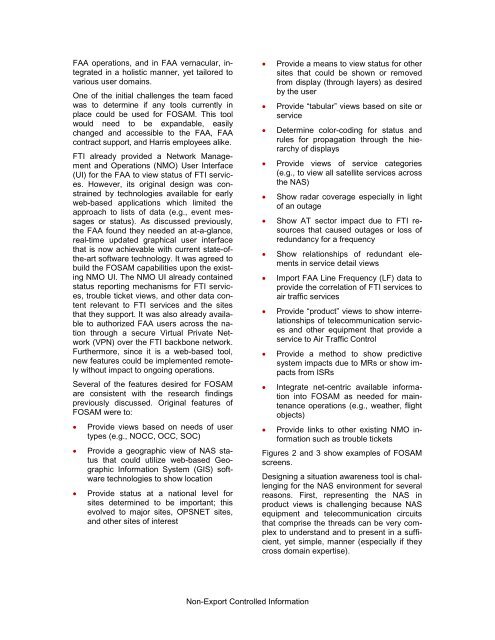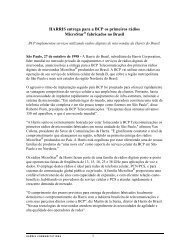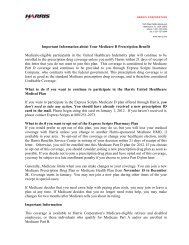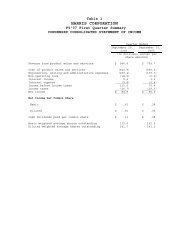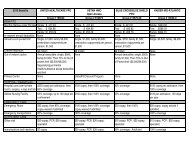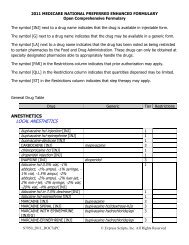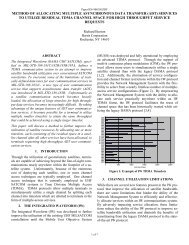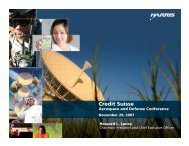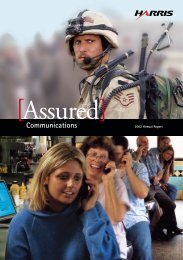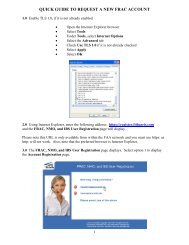Advancing Situational Awareness for Technical Operations
Advancing Situational Awareness for Technical Operations
Advancing Situational Awareness for Technical Operations
You also want an ePaper? Increase the reach of your titles
YUMPU automatically turns print PDFs into web optimized ePapers that Google loves.
FAA operations, and in FAA vernacular, integrated<br />
in a holistic manner, yet tailored to<br />
various user domains.<br />
One of the initial challenges the team faced<br />
was to determine if any tools currently in<br />
place could be used <strong>for</strong> FOSAM. This tool<br />
would need to be expandable, easily<br />
changed and accessible to the FAA, FAA<br />
contract support, and Harris employees alike.<br />
FTI already provided a Network Management<br />
and <strong>Operations</strong> (NMO) User Interface<br />
(UI) <strong>for</strong> the FAA to view status of FTI services.<br />
However, its original design was constrained<br />
by technologies available <strong>for</strong> early<br />
web-based applications which limited the<br />
approach to lists of data (e.g., event messages<br />
or status). As discussed previously,<br />
the FAA found they needed an at-a-glance,<br />
real-time updated graphical user interface<br />
that is now achievable with current state-ofthe-art<br />
software technology. It was agreed to<br />
build the FOSAM capabilities upon the existing<br />
NMO UI. The NMO UI already contained<br />
status reporting mechanisms <strong>for</strong> FTI services,<br />
trouble ticket views, and other data content<br />
relevant to FTI services and the sites<br />
that they support. It was also already available<br />
to authorized FAA users across the nation<br />
through a secure Virtual Private Network<br />
(VPN) over the FTI backbone network.<br />
Furthermore, since it is a web-based tool,<br />
new features could be implemented remotely<br />
without impact to ongoing operations.<br />
Several of the features desired <strong>for</strong> FOSAM<br />
are consistent with the research findings<br />
previously discussed. Original features of<br />
FOSAM were to:<br />
• Provide views based on needs of user<br />
types (e.g., NOCC, OCC, SOC)<br />
• Provide a geographic view of NAS status<br />
that could utilize web-based Geographic<br />
In<strong>for</strong>mation System (GIS) software<br />
technologies to show location<br />
• Provide status at a national level <strong>for</strong><br />
sites determined to be important; this<br />
evolved to major sites, OPSNET sites,<br />
and other sites of interest<br />
Non-Export Controlled In<strong>for</strong>mation<br />
• Provide a means to view status <strong>for</strong> other<br />
sites that could be shown or removed<br />
from display (through layers) as desired<br />
by the user<br />
• Provide “tabular” views based on site or<br />
service<br />
• Determine color-coding <strong>for</strong> status and<br />
rules <strong>for</strong> propagation through the hierarchy<br />
of displays<br />
• Provide views of service categories<br />
(e.g., to view all satellite services across<br />
the NAS)<br />
• Show radar coverage especially in light<br />
of an outage<br />
• Show AT sector impact due to FTI resources<br />
that caused outages or loss of<br />
redundancy <strong>for</strong> a frequency<br />
• Show relationships of redundant elements<br />
in service detail views<br />
• Import FAA Line Frequency (LF) data to<br />
provide the correlation of FTI services to<br />
air traffic services<br />
• Provide “product” views to show interrelationships<br />
of telecommunication services<br />
and other equipment that provide a<br />
service to Air Traffic Control<br />
• Provide a method to show predictive<br />
system impacts due to MRs or show impacts<br />
from ISRs<br />
• Integrate net-centric available in<strong>for</strong>mation<br />
into FOSAM as needed <strong>for</strong> maintenance<br />
operations (e.g., weather, flight<br />
objects)<br />
• Provide links to other existing NMO in<strong>for</strong>mation<br />
such as trouble tickets<br />
Figures 2 and 3 show examples of FOSAM<br />
screens.<br />
Designing a situation awareness tool is challenging<br />
<strong>for</strong> the NAS environment <strong>for</strong> several<br />
reasons. First, representing the NAS in<br />
product views is challenging because NAS<br />
equipment and telecommunication circuits<br />
that comprise the threads can be very complex<br />
to understand and to present in a sufficient,<br />
yet simple, manner (especially if they<br />
cross domain expertise).


